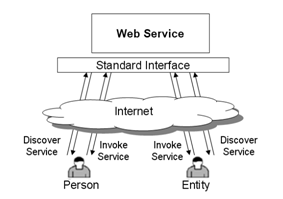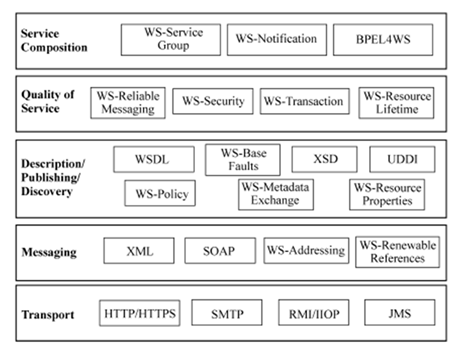From SSKE
| Line 1: | Line 1: | ||
The paradigm of Web Services is changing the Internet from a repository of web content to one that stores and hosts services. Each organization can now expose its business applications as services on the Internet, making them accessible by means of standard programmatic interfaces, thus facilitating collaboration between businesses within and across enterprise boundaries. Distributed computing and resource sharing over the Internet is now enhanced with an increased cross-language and cross-platform interoperability. In addition, independently published Web services can be composed and integrated into Web applications, thus enabling a new quick and cost-effective way of software engineering for the efficient implementation of new business processes. | The paradigm of Web Services is changing the Internet from a repository of web content to one that stores and hosts services. Each organization can now expose its business applications as services on the Internet, making them accessible by means of standard programmatic interfaces, thus facilitating collaboration between businesses within and across enterprise boundaries. Distributed computing and resource sharing over the Internet is now enhanced with an increased cross-language and cross-platform interoperability. In addition, independently published Web services can be composed and integrated into Web applications, thus enabling a new quick and cost-effective way of software engineering for the efficient implementation of new business processes. | ||
| − | Web services are programmable modules that present standard interface descriptions and can be universally accessed through standard communication protocols. The specification of a Web service’s functionalities is language and platform independent and these functionalities can only be accessed through its published interfaces via the Internet. | + | Web services are programmable modules that present standard interface descriptions and can be universally accessed through standard communication protocols. The specification of a Web service’s functionalities is language and platform independent and these functionalities can only be accessed through its published interfaces via the Internet. The use of web services follows the flow described in the SOA operational model: they will be first modeled by a provider and then published by them in a service repository where requestors can perform queries in order to find what best suites their interest. After the query returns the proper location of the service provider, the requestor will be able to invoke the service. |
| − | The use of web services follows the flow described in the SOA operational model | + | |
| + | [[File:Web Services flow.PNG|center]] | ||
| − | For each stage in the flow of Web services a variety of standardization and leading industrial organizations have been collaborating in order to define a set of emerging standards. Currently, standards for Web services exist at multiple levels. | + | <br/>For each stage in the flow of Web services a variety of standardization and leading industrial organizations have been collaborating in order to define a set of emerging standards. Currently, standards for Web services exist at multiple levels. |
| + | [[File:Web Services standards.PNG|center]] | ||
[[Category:SSKE Knowledge/Web Services|SSKE_Knowledge/Web_Services]] | [[Category:SSKE Knowledge/Web Services|SSKE_Knowledge/Web_Services]] | ||
Latest revision as of 03:29, 5 July 2012
The paradigm of Web Services is changing the Internet from a repository of web content to one that stores and hosts services. Each organization can now expose its business applications as services on the Internet, making them accessible by means of standard programmatic interfaces, thus facilitating collaboration between businesses within and across enterprise boundaries. Distributed computing and resource sharing over the Internet is now enhanced with an increased cross-language and cross-platform interoperability. In addition, independently published Web services can be composed and integrated into Web applications, thus enabling a new quick and cost-effective way of software engineering for the efficient implementation of new business processes.
Web services are programmable modules that present standard interface descriptions and can be universally accessed through standard communication protocols. The specification of a Web service’s functionalities is language and platform independent and these functionalities can only be accessed through its published interfaces via the Internet. The use of web services follows the flow described in the SOA operational model: they will be first modeled by a provider and then published by them in a service repository where requestors can perform queries in order to find what best suites their interest. After the query returns the proper location of the service provider, the requestor will be able to invoke the service.
For each stage in the flow of Web services a variety of standardization and leading industrial organizations have been collaborating in order to define a set of emerging standards. Currently, standards for Web services exist at multiple levels.





